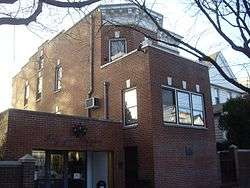Louis Armstrong House
The Louis Armstrong House, formally known as 34-56 107th Street, is a historic house museum in Corona, Queens, New York City.[3][4] It was the home of Louis Armstrong and his wife Lucille Wilson from 1943 until his death in 1971. Lucille gave ownership of it to the city of New York in order to create a museum focused on her husband.
Louis Armstrong House | |
 Louis Armstrong House, December 2007 | |
   | |
| Location | 34-56 107th Street, Queens, New York |
|---|---|
| Coordinates | 40°45′20″N 73°51′43″W |
| Built | 1910[1] |
| Architect | Robert W. Johnson[1] |
| NRHP reference No. | 76001265 |
| Significant dates | |
| Added to NRHP | May 11, 1976[2] |
| Designated NHL | May 11, 1976[3] |
| Designated NYCL | December 13, 1988 |
The house was designated a New York City Landmark in 1988[1] and declared a National Historic Landmark in 1976. It now serves as a museum that presents concerts and educational programs, and makes materials in its archives of writings, books, recordings and memorabilia available to the public for research.
Background
The Louis Armstrong Educational Foundation gave the house to the Department of Culture Affairs after Lucille Armstrong died in 1983. This brick house was designed by architect Robert W. Johnson and built by Thomas Daly in 1910.[5] Some changes were made to the exterior and interior of the house when the Armstrongs moved in. The porch that was once in the front of the house was taken down and the space was added to the living room. For the exterior of the house the garden was assembled and the garage was constructed by the Armstrongs.[6]
In addition the interior of the house was renovated to their taste.[7] Ornate bathrooms, and the kitchen was not originally part of the house. Paintings and souvenirs were given to Louis Armstrong on tour from Asia, Europe to Africa. These gifts have found a home of their own on dressers, night stands, shelves and walls.
See also
- List of music museums
- John Coltrane Home
- List of New York City Designated Landmarks in Queens
- National Register of Historic Places listings in Queens County, New York
References
- Dolkart, Andrew S. & Postal, Matthew A.; Guide to New York City Landmarks, 3rd Edition; New York City Landmarks Preservation Commission; John Wiley & Sons, Inc. 2004. ISBN 0-471-36900-4; p.283.
- "National Register Information System". National Register of Historic Places. National Park Service. January 23, 2007.
- "Louis Armstrong House". National Historic Landmark summary listing. National Park Service. 2007-09-15. Archived from the original on 2013-10-29.
- Lynne Gomez Graves (February 3, 1976). "National Register of Historic Places Inventory-Nomination: Louis Armstrong House" (PDF). National Park Service. Cite journal requires
|journal=(help) and Accompanying photos, exterior, from 1976 (1.36 MB) - "Archived copy". Archived from the original on 2013-06-13. Retrieved 2016-11-17.CS1 maint: archived copy as title (link)
- http://www2.cuny.edu/wp-content/uploads/sites/4/2015/01/QueensCollege_HistoricLandmark.pdf
- Hill, Miriam. "Louis Armstrong's house in Queens opens as museum". baltimoresun.com.
External links

- The Official Site of the Louis Armstrong House & Archives

